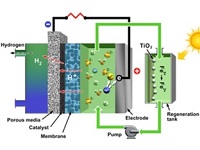Energy Conversion and Storage System

Technology Description:
Proton Energy Systems will develop a hydrogen-iron flow battery that can generate hydrogen for use and energy storage on the electric grid. This dual-purpose device can be recharged using renewable grid electricity and either store the hydrogen or run in reverse, as a flow cell battery, when electricity is needed. The team will develop low-cost catalysts to use on both electrodes and leverage their expertise in system engineering to keep the costs low. By using two highly reversible single electron reactions, the round trip efficiency could exceed 80%. By operating at much higher efficiencies than traditional electrolyzers, this technology could offer multiple value streams thereby enabling widespread adoption of distributed storage and hydrogen fueling.
Potential Impact:
If successful, this technology could yield greatly improved water electrolyzers, which could enable low-cost energy storage compatible with intermittent renewable energy sources, such as solar and wind power.
Security:
Storing energy from intermittent renewables over long durations in a cost-effective manner could reduce demand on the electric grid, while produced H2 or derived liquids could provide a low-carbon alternative to fossil fuels for transportation.
Environment:
Clean energy storage technologies could allow high penetration of emissions-free renewable power.
Economy:
The team’s innovations could reduce the cost of long-term energy storage and therefore enable renewables to be more cost competitive with conventional generation sources.
Contact
ARPA-E Program Director:
Dr. Grigorii Soloveichik
Project Contact:
Dr. Katherine Ayers
Press and General Inquiries Email:
ARPA-E-Comms@hq.doe.gov
Project Contact Email:
kayers@protononsite.com
Partners
Pacific Northwest National Laboratory
Related Projects
Release Date:
01/07/2015
